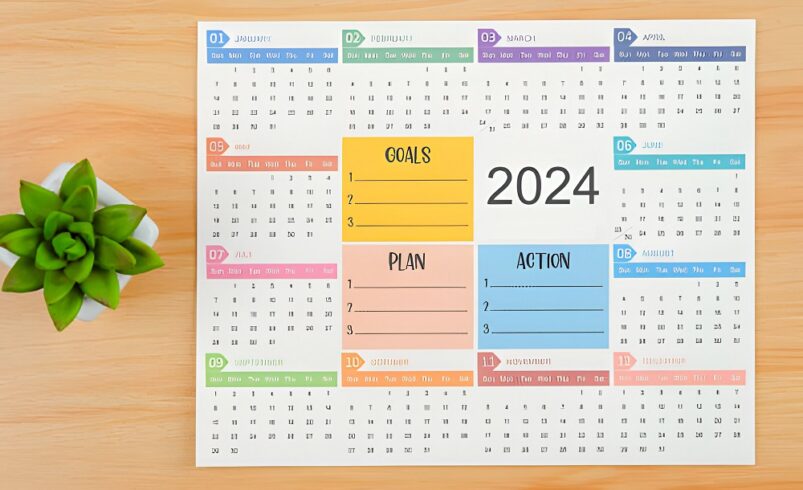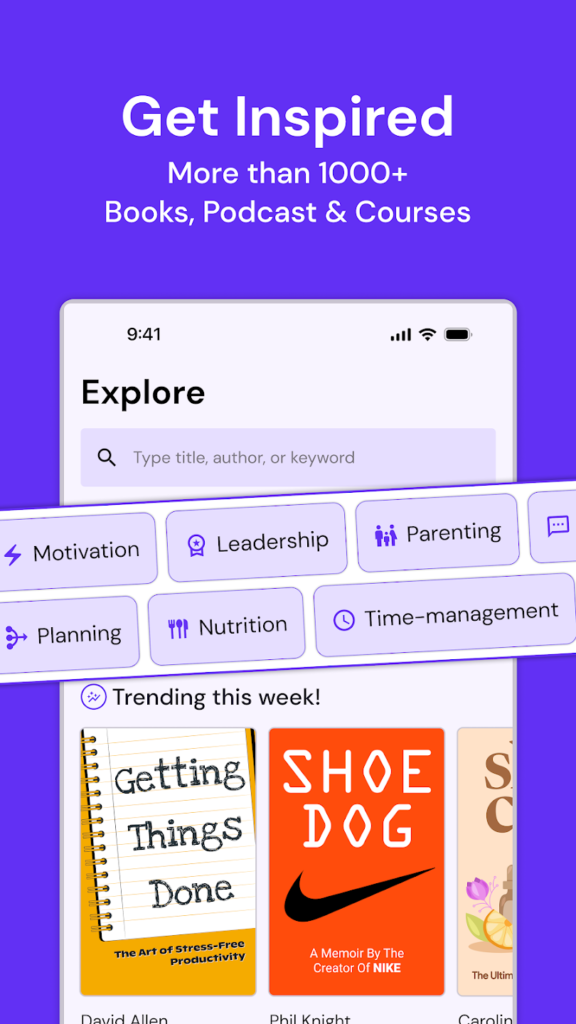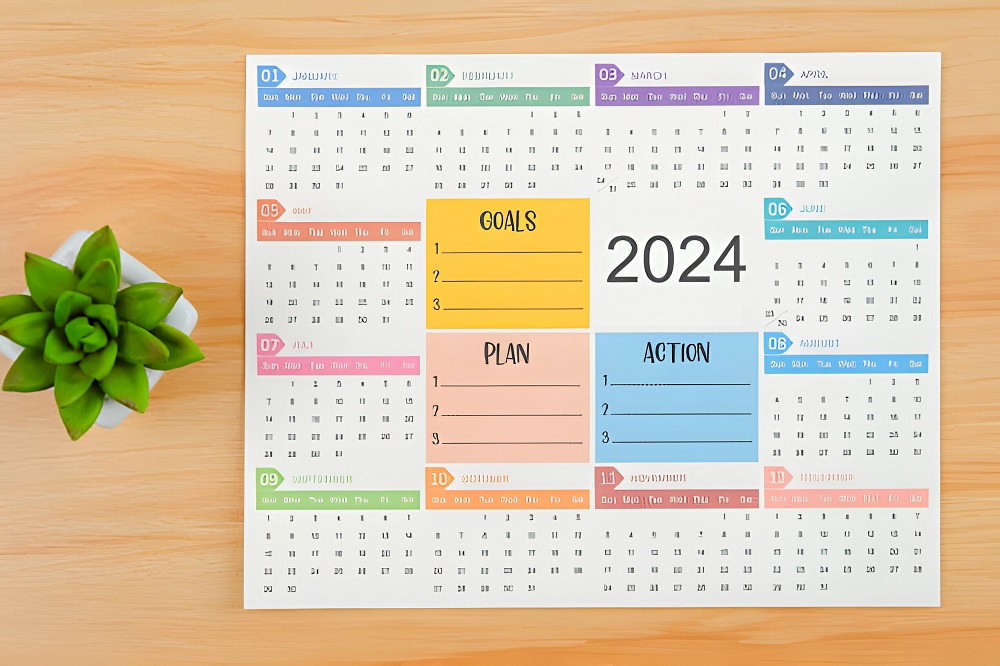
We’ve all been there – making vague promises to ourselves like, “I’ll get in shape this year,” or “I’ll save more money.” The intention is solid, but without a clear plan, these goals tend to fizzle out as quickly as they’re made. That’s where SMART goals come in. If you’re unfamiliar, SMART is an acronym that stands for Specific, Measurable, Achievable, Relevant, and Time-bound. By using this structured approach, you’re giving yourself a roadmap for success, making those goals far more likely to be achieved.
This blog post will delve into what SMART goals are, how they can help transform your life, and how to set and implement them in a practical way. And as a bonus, I’ll introduce you to the Wizdom app, a handy tool to level up your personal development game with insightful self-help books.
Contents
- 1 5-Second Summary:
- 2 What Are SMART Goals?
- 3 Why Are SMART Goals Helpful?
- 4 The Importance of SMART Goals in Individual and Business Settings
- 5 The 5 Elements of SMART Goals: Breaking it Down
- 6 How to Set SMART Goals
- 7 Step-by-Step Guide to Setting SMART Goals:
- 8 Example: A SMART Fitness Goal
- 9 How to Incorporate SMART Goals Into Your Daily Life
- 10 Tips for Incorporating SMART Goals Into Daily Life:
- 11 Questionnaire: Are Your Goals SMART?
- 12 The Wizdom App: A Companion for Your SMART Journey
- 13 Suggested Books on the Wizdom App for Goal-Setting:
5-Second Summary:
SMART goals turn vague, hard-to-achieve ambitions into clear, actionable plans. By making goals Specific, Measurable, Achievable, Relevant, and Time-bound, you’ll stay focused, track progress, and boost your chances of success.
Meet Sarah, a project manager at a tech company. Her team was tasked with increasing client satisfaction, but with the broad team-wide goal of “improve customer service,” progress stalled. No one knew what specific steps to take, and the team lacked direction. Frustrated, Sarah revamped the goal using the SMART framework:
Specific – improve client onboarding;
Measurable – reduce onboarding time by 15%;
Achievable – use existing software tools;
Relevant – client retention depends on good onboarding;
Time-bound – complete the improvement in three months.
With SMART goals, Sarah’s team had a clear path forward, tracked progress, and ultimately exceeded their target, boosting client satisfaction by 20%.
What Are SMART Goals?
SMART goals take the guesswork out of goal-setting by forcing you to drill down into the specifics. It’s not enough to just say, “I want to improve.” SMART goals provide a framework that makes sure you know how to improve, when you’ll improve, and what success will look like when you get there.
Here’s a breakdown of the SMART acronym:
– Specific: Your goal should be clear and unambiguous.
– Measurable: You need a way to track progress and know when you’ve achieved it.
– Achievable: The goal should be realistic, something you can actually accomplish.
– Relevant: It should matter to you and align with your broader life ambitions.
– Time-bound: Your goal needs a deadline to create urgency and prevent procrastination.
Think of SMART goals as your personal GPS system – without it, you may end up driving in circles.
Why Are SMART Goals Helpful?
Ever wondered why New Year’s resolutions are often abandoned by February? It’s usually because they’re too broad and unstructured. Goals like “get fit” or “be happier” aren’t inherently bad, but without a clear, actionable path, they can feel overwhelming.
Here’s where SMART goals save the day. They not only help you clarify your intentions but also give you a practical way to measure your progress. Here’s how they can be a game changer:
– Focus: Instead of juggling a hundred vague ambitions, you have clear priorities.
– Motivation: As you see progress, you’re more likely to stay motivated.
– Efficiency: With specific steps laid out, you’re less likely to waste time on irrelevant tasks.
– Accountability: Because SMART goals are measurable, you can check in on your progress and hold yourself accountable.
The Importance of SMART Goals in Individual and Business Settings
SMART goals are like the GPS of life – they tell you exactly where you’re going and how to get there without making you drive in circles or bang your head against the dashboard. Whether you’re an individual trying to get your act together or a business looking to hit those big performance targets, SMART goals are crucial because they take the guesswork out of success.
For individuals, setting SMART goals can be a total game-changer. Ever told yourself, “This is the year I’m going to get fit,” only to find yourself three months in, eating pizza on the couch, wondering where it all went wrong? Yeah, we’ve all been there. The problem is, vague goals like “get fit” or “save more money” don’t give you a clear path to follow, so it’s easy to lose motivation. SMART goals, however, force you to get specific. Instead of “get fit,” you might say, “I’ll run a 5K in three months by jogging three times a week for 30 minutes.” Boom. Now you’ve got a plan! And because it’s measurable, you can track your progress, feel good about those small wins along the way, and know exactly when to celebrate with a post-5K victory pizza (balance, right?).
Businesses need SMART goals just as much as individuals do, and maybe even more. When a company says, “Let’s increase sales this quarter,” without laying out exactly how or by how much, it’s basically like sending your team into a maze with a blindfold on. Sure, they might stumble into success, but the odds aren’t in their favour. With SMART goals, you can guide them step by step. Specificity eliminates confusion: “Increase sales by 15% by focusing on upselling to existing customers” is a way clearer goal than just “do better.” Measurable goals allow you to track progress and see what’s working, and that data is gold for keeping everyone on track.
Plus, let’s be real: without deadlines, some tasks will just float around forever like that mysterious Tupperware in the back of your fridge. Time-bound goals light a fire under you (or your team), creating urgency and making sure everyone is pulling their weight. And, of course, setting achievable goals keeps you grounded – nobody likes a boss or a personal trainer who sets you up for failure by asking for the impossible, like running a marathon when you’ve barely managed a jog around the block.
SMART goals also create accountability. For individuals, they make you your own boss (minus the awkward performance reviews). You know what you need to do and when, so there’s no room for slacking. And when businesses set SMART goals, it creates transparency. Everyone knows what’s expected, which means fewer meetings where people just nod along while silently wondering, “What exactly are we supposed to be doing again?”
Lastly, SMART goals help keep everyone – whether it’s just you, or an entire team – focused on what truly matters. They weed out the distractions and shiny objects that don’t contribute to the bigger picture. That’s especially important in the workplace, where it’s easy to get bogged down with tasks that don’t actually move the needle. With relevant goals, everyone knows how their efforts tie into the company’s broader mission, so no one’s wasting time on things that won’t pay off.
In both personal and professional settings, SMART goals also make success feel achievable. You don’t have to wait until the end to celebrate – you can acknowledge those little milestones along the way. For individuals, this might mean treating yourself after sticking to your fitness routine for a month (yay, you!). For businesses, it creates a more engaged and motivated team, because people can see how their contributions make a real impact. And trust me, when you hit those milestones, it feels so much better than that vague sense of “I should be doing something.”
In short, SMART goals give you a real shot at success, whether you’re aiming to lose 10 pounds, crush your sales targets, or just finally clear out that mystery Tupperware from your fridge.
The 5 Elements of SMART Goals: Breaking it Down
SMART goals are all about bringing clarity and focus to your ambitions. By breaking them down into five distinct elements – Specific, Measurable, Achievable, Relevant, and Time-bound – you are setting yourself up for success in a structured and manageable way. Each element serves a crucial role: the Specific aspect ensures your goal is crystal clear and unambiguous, so you know exactly what you’re working toward. The Measurable component allows you to track progress and see tangible evidence of your efforts, keeping you motivated. Making your goal Achievable is about setting realistic expectations; it’s important to challenge yourself, but overreaching can lead to burnout or discouragement. The Relevant part keeps your goals aligned with your long-term aspirations and current life situation, ensuring that you’re not working toward something that doesn’t really matter to you. Finally, the Time-bound element creates a sense of urgency by giving your goal a deadline, pushing you to take action and stay focused. Together, these five elements act as a roadmap, turning your vague ambitions into clear, actionable plans with measurable milestones along the way. When you fully embrace each of these components, you’re not just setting a goal – you’re creating a blueprint for success.
- Specific
When it comes to goal-setting, vagueness is the enemy. If your goal is too broad, it’s difficult to know what you’re working towards. A specific goal is clear and easy to understand. Ask yourself these questions when defining your goal:
– What exactly do I want to accomplish?
– Who is involved in this goal?
– Where will it happen?
– When do I want to start and finish?
Let’s take a classic example: “I want to get in shape.” That’s too vague. A specific goal would look something like this: “I want to lose 10 pounds by working out 4 times a week and eating healthier meals.” Now that’s something actionable.
- Measurable
If you can’t measure it, how will you know when you’ve achieved it? Metrics are essential for tracking your progress and staying motivated. Here are some questions to consider:
– How much or how many?
– How will I know when I’ve reached my goal?
In our example, losing 10 pounds is measurable. You’ll be able to see your progress on the scale and adjust your strategy if needed.

- Achievable
Setting a goal that’s too lofty can actually demotivate you. It’s important to be honest about what you can accomplish based on your current resources and constraints. Ask yourself:
– Do I have the tools and resources to achieve this goal?
– Is this goal realistic given my current lifestyle?
For example, if you have a demanding job, aiming to work out twice a day might not be achievable. Aiming for 4 workouts a week? Much more doable.
- Relevant
Your goals should align with your larger life objectives and aspirations. If a goal doesn’t matter to you personally, you’re unlikely to stick with it. Ask yourself:
– Is this goal aligned with my broader ambitions?
– Why is this goal important to me right now?
If you’ve always wanted to run a marathon, setting a fitness goal is highly relevant. If running isn’t your thing, maybe a different physical goal – like hiking or cycling – would be more relevant to your life.
- Time-bound
A goal without a deadline is just a dream. A time frame gives you something to work toward and keeps the urgency high. Ask yourself:
– What’s my deadline for achieving this goal?
– What milestones can I set along the way?
For instance, “I want to lose 10 pounds in 3 months” has a clear timeframe. You can then break that down into smaller, more manageable milestones (like losing 3 pounds per month).
Drawbacks to SMART Goals:
Everything has a negative side to it – including things specifically made to be good.
While SMART goals are undeniably effective in creating structure and clarity, they aren’t without their drawbacks. One major issue is that SMART goals can sometimes be too rigid. By focusing so much on specific, measurable, and time-bound outcomes, you can unintentionally limit creativity and flexibility. For example, if you’re too fixated on achieving a precise goal within a certain timeframe, you may miss out on unexpected opportunities or alternative paths that could be even more beneficial. This rigidity can also lead to stress, especially if life circumstances change and the goal no longer feels achievable, but you’re stuck with a deadline staring you in the face.
Another limitation is that SMART goals can encourage people to set goals that are too safe or easy. The emphasis on “achievable” often leads individuals and businesses to avoid taking risks, aiming for what feels possible rather than pushing boundaries. This can result in stagnation, as people may set goals that don’t challenge them enough, limiting their potential for growth. Sometimes, bigger, more ambitious goals, though not entirely “achievable” by SMART standards, could drive innovation and lead to greater breakthroughs.
Lastly, the overemphasis on measurable outcomes can reduce the focus on qualitative aspects of success. Not everything that’s important can be easily quantified. For instance, personal growth, improving relationships, or developing soft skills might not fit neatly into the SMART framework, leading to these areas being neglected in favour of more tangible goals. In businesses, this might result in a focus on short-term, easy-to-measure wins instead of long-term strategies that build sustainable success. Ultimately, while SMART goals offer valuable structure, they can also box you in and limit the scope of what you might otherwise achieve.
How to Set SMART Goals
Now that we’ve covered the components, it’s time to put them into action. Setting SMART goals doesn’t have to be complicated, but it does require some thought and reflection.
Step-by-Step Guide to Setting SMART Goals:
- Identify your broad goals: Write down everything you want to achieve in a certain timeframe (e.g., this year).
- Break them down: Use the SMART framework to turn each broad goal into something specific, measurable, achievable, relevant, and time-bound.
- Create action steps: For each goal, outline the steps you’ll need to take to achieve it.
- Set checkpoints: Schedule times to review your progress. Adjust if necessary.
- Stay accountable: Share your goals with a friend or use a goal-tracking app.
Example: A SMART Fitness Goal
Let’s say your broad goal is to “improve your fitness.”
Here’s how you’d SMARTen it up:
– Specific: “I want to improve my cardiovascular health by running a 5K.”
– Measurable: “I’ll start by running 1 mile, three times a week, and gradually increase the distance.”
– Achievable: “I’ve already done some jogging, so I know I can start with 1 mile.”
– Relevant: “Improving my fitness will help with my overall health and stress levels.”
– Time-bound: “I will run the 5K in 10 weeks.”
How to Incorporate SMART Goals Into Your Daily Life
Setting SMART goals is great, but how do you make sure you follow through? Here’s where the rubber meets the road. You need to integrate your goals into your daily routine.
Tips for Incorporating SMART Goals Into Daily Life:
- Prioritise your goals: Not all goals need daily attention. Focus on your most important one first.
- Break them down into daily tasks: If your goal is to run a 5K, your daily task might be a 15-minute jog.
- Use a planner or app: Track your progress with tools like calendars, to-do lists, or goal-tracking apps.
- Stay flexible: Life happens. Adjust your goals or timelines as needed, but don’t abandon them completely.
- Celebrate small wins: Every little step counts. Reward yourself for hitting milestones to stay motivated.
Questionnaire: Are Your Goals SMART?
If you’re unsure whether your goals fit the SMART framework, here’s a quick questionnaire to help:
- Is your goal specific? Yes / No
- Can you measure your progress? Yes / No
- Is the goal realistically achievable? Yes / No
- Does it align with your broader ambitions? Yes / No
- Have you set a deadline? Yes / No
If you answered “No” to any of these, go back and revise your goal.
The Wizdom App: A Companion for Your SMART Journey
Now that you’ve learned how to set SMART goals, you might be wondering how to keep yourself motivated and inspired throughout your journey. Enter the Wizdom App.
The Wizdom app is a treasure trove of self-help and personal development books, designed to give you actionable insights on a variety of topics – from goal-setting to improving relationships and productivity. Here’s how it can enhance your journey:
- Daily Motivation
Wizdom offers daily book summaries that provide you with fresh, bite-sized chunks of inspiration. Instead of aimlessly scrolling through social media, you can spend a few minutes reading something that fuels your personal growth.
- Practical Advice
The books featured on Wizdom offer practical, actionable advice. You won’t just be reading about goal-setting; you’ll find clear, structured ways to apply these principles to your life. The insights you gain can directly contribute to the success of your SMART goals.
- Habit Tracking
You can use Wizdom’s habit-tracking features (daily streaks, time spent reading, etc.) to track your daily progress. Whether you’re trying to develop a new skill, exercise more, or improve your mental health, having a digital companion can help keep you accountable.
- Wide Range of Topics
Wizdom offers books on various topics, so you can always find content that aligns with your current goals. Whether you want to improve your financial literacy, boost your career, or simply become more mindful, there’s something for everyone.
- Flexibility
Not everyone has time to sit down and read an entire book. Wizdom’s summaries allow you to absorb the key messages in a fraction of the time. This is perfect if you have a busy schedule but still want to work on self-improvement.
Suggested Books on the Wizdom App for Goal-Setting:
– Atomic Habits by James Clear
– The Power of Habit by Charles Duhigg
– Essentialism by Greg McKeown
Achieving your dreams isn’t just about setting goals – it’s about setting the right goals. SMART goals provide the clarity, structure, and motivation you need to actually get stuff done. By setting specific, measurable, achievable, relevant, and time-bound goals, you’re setting yourself up for success. And with the help of tools like the Wizdom app, you’ll have access to a wealth of knowledge and motivation that will support your journey.
So, what are you waiting for? Get out there and start making your goals a reality – one SMART step at a time.

Zia Hawwa
Currently pursuing a Degree in Criminology, Zia’s passions lie in the world of literature and the human psyche. She loves what the world has to offer, and is always on the journey of satisfying her curiosity.

The Complete Guide to Setting Weekly Goals (25 Examples)

Top 10 Books like The Lean Startup
Recent Posts
- 25 Top Quotes from The 10X Rule to Supercharge Your Ambition
- 10 Books You Must Read to Succeed in Your Career
- 30 Little Tricks for Big Success in Relationships
- 25 Life-Changing Self-Help Books to Read This December: Boost Your Mood and Your Mind
- 25 Amazing Self-Care Tips for December: Wrap Yourself in Joy, Not Stress


